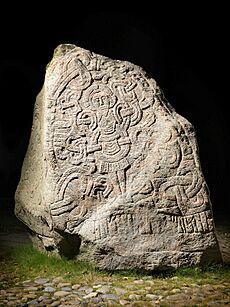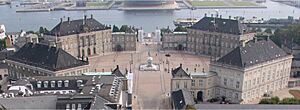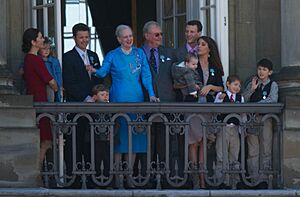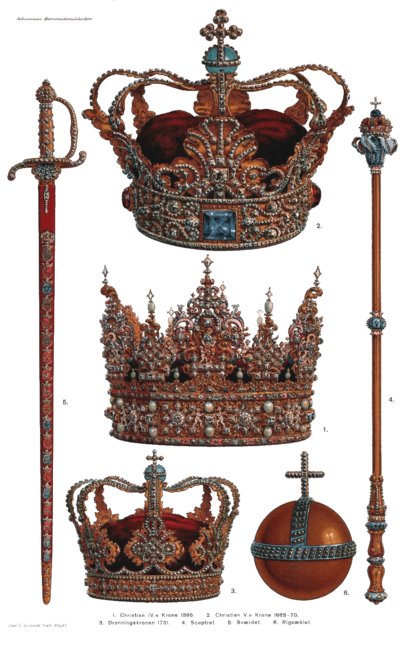Monarchy of Denmark facts for kids
Quick facts for kids His Majesty the King of the Kingdom of Denmark |
|
|---|---|
| Konge af Danmark | |
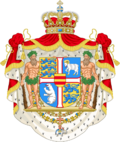
Royal coat of arms of Denmark
|
|
| Incumbent | |
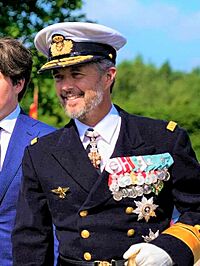 |
|
| Frederik X since 14 January 2024 |
|
| Details | |
| Style | His Majesty |
| Heir apparent | Christian, Crown Prince of Denmark |
| First monarch | Ongendus (first king known by name) |
| Formation | 710 |
| Residences | See list |
The Monarchy of Denmark is a special part of the Kingdom of Denmark. It's a system where a king or queen is the head of state. The Kingdom of Denmark includes Denmark itself, plus the self-governing areas of the Faroe Islands and Greenland. Denmark became a unified kingdom a very long time ago, around the 8th century. Its rulers were called "kings" even back then.
The modern Kingdom of Denmark was brought together by the Viking kings Gorm the Old and Harald Bluetooth in the 10th century. At first, kings were chosen, but in the 17th century, it became a hereditary role, meaning it passed down in the family. A big change happened in 1849 when Denmark got its first democratic constitution. This new constitution greatly limited the king's power. Today, the Danish Royal Family belongs to the House of Glücksburg. This family also provided monarchs for Norway, the United Kingdom, and formerly Greece.
The Danish monarchy is a constitutional monarchy. This means the monarch's role is set and limited by the Constitution of Denmark. While the constitution says the monarch has executive power, in reality, these powers are used only according to laws passed by the Parliament. The monarch mainly performs non-political duties. These include giving out honours and formally appointing the prime minister. The monarch and their family also do many official, ceremonial, and diplomatic jobs.
King Frederik X became king on January 14, 2024. He took over after his mother, Queen Margrethe II, stepped down. Danish kings have traditionally alternated names between "Frederik" and "Christian" since 1513. So, King Frederik's son and heir is Crown Prince Christian.
Contents
The Danish Monarchy: Kings, Queens, and History
A Look Back: How it Started
The Danish monarchy is over 1200 years old. It began in the 8th century or even earlier. The line of kings we know today can be traced back to Harthacnut, who was the father of Gorm the Old. Gorm ruled in the early to mid-10th century. The kingdom itself is likely even older.
The Danes were united and officially became Christian in 965 AD by Harald Bluetooth. This story is carved on the famous Jelling stones. We don't know the exact size of Harald's kingdom. But it likely included Jutland, the Danish islands, and parts of southern Sweden. Harald also "won" Norway, according to the Jelling stones.
Harald's son, Sweyn Forkbeard, led many wars against England. His son, Cnut the Great, finished these conquests by the mid-11th century. Cnut's rule was the peak of the Danish Viking Age. His "North Sea Empire" included England, Denmark, and Norway. It also had a strong influence over Germany's northeastern coast.
The last monarch from the line of Valdemar IV died in 1448. After this, Count Christian of Oldenburg was chosen as the next king. He became Christian I. He was related to the old royal family through his mother's side.
At first, Danish kings were chosen, though usually the oldest son was picked. Kings also had to sign a special agreement called a Coronation Charter. This charter limited their powers.
In 1657, King Frederick III started a war against Sweden. This war turned into a disaster for Denmark. One reason was that Denmark's ally, the Netherlands, stayed neutral. Another reason was that the Belts (waterways) froze over. This allowed the Swedish King Charles X Gustav of Sweden to march his army across the ice to invade Zealand. Denmark had to give up many lands, including parts of Sweden and Norway, in the Treaty of Roskilde.
But the war wasn't over. Three months later, Charles X Gustav decided to try and take over all of Scandinavia. He attacked Copenhagen again. This time, the Danes fought back. Frederick III stayed in the city and encouraged his people to resist. He famously said he would "die in his nest." The Netherlands also sent help, saving Copenhagen from being captured.
Charles X Gustav died suddenly in 1660. After his death, Sweden made peace in the Treaty of Copenhagen. Sweden returned some lands to Norway and Denmark but kept others. This treaty set the borders between Norway, Denmark, and Sweden that we still see today.
After these wars, the king gained more power. In 1660-1661, the monarchy became hereditary and absolute. This meant the king had total power. The "King's Law" of 1665 made this official. It also set up male primogeniture, meaning the oldest son would inherit the throne.
The Shift to a Constitutional Monarchy

When Frederick VII became king in 1848, people immediately demanded a constitution. They wanted to end the king's absolute power. Frederick VII agreed to these demands. In March 1848, he accepted the end of absolutism. This led to the June Constitution of 1849. This constitution created a constitutional monarchy for Denmark.
Since Frederick VII had no children, Prince Christian of Glücksborg was chosen as the next heir in 1853. This was approved by other European powers. Christian IX became the first Danish monarch from the House of Glücksburg. He was known as the Father-in-law of Europe because his children married into many other royal families across Europe. For example, his daughter Alexandra married the future King Edward VII of the United Kingdom.
The Easter Crisis of 1920
The Easter Crisis of 1920 was a big moment for Denmark's government. It started when King Christian X fired the elected government. He had the power to do this according to the constitution. The king and the government disagreed about whether a part of Schleswig should rejoin Denmark.
The Prime Minister, Carl Theodor Zahle, felt he didn't have to follow the king's order. He resigned. Christian X then fired the rest of the government and put in a temporary one. This caused big protests and a lot of tension in Denmark. For a few days, it seemed like the monarchy might be overthrown.
But the king and the Social Democrats party started talking. Christian X eventually backed down and fired his own temporary government. This was the last time a Danish monarch made a big decision without the support of the government. After this crisis, Christian X accepted that his role was mostly symbolic.
In 1953, a new law changed the rules for who could inherit the throne. It allowed women to inherit if they had no brothers. This made Princess Margrethe the heir to her father, Frederik IX. When Frederik IX died in 1972, Queen Margrethe II became queen. She reigned until she stepped down in 2024.
Another change happened in 2009. A new law made it so that the first-born child inherits the throne, no matter if they are a boy or a girl. This is called absolute primogeniture.
What the Monarch Does Today
According to the Danish Constitution, the Danish monarch is the head of state. They are also the symbolic commander-in-chief of the Danish Armed Forces. The monarch is also the head of the Church of Denmark and the Danish Honours system.
However, in practice, the monarch's powers are mostly symbolic. When the constitution mentions the "king" doing something, it usually means the Government (the Prime Minister and other ministers). These ministers are responsible for all government actions. This means the monarch is not politically or legally responsible for decisions.
Today, the monarch lets the government ministers handle most royal authority. This allows the king to focus on the ceremonial role described in the constitution. The Prime Minister and Cabinet meet regularly with the monarch in the Council of State. Here, the monarch formally approves new laws. The Prime Minister and Foreign Minister also regularly update the monarch on political news.
The monarch hosts visits from foreign leaders and makes state visits to other countries. They also receive official papers from foreign ambassadors and sign those for Danish ambassadors. After a general election, the monarch meets with political parties. They then invite the leader with the most support in Parliament to form a government. Once the government is formed, the monarch formally appoints it.
Greenland and the Faroe Islands
Greenland and the Faroe Islands are part of the Kingdom of Denmark. So, the monarch of Denmark is also their head of state.
In 2009, Greenland had a vote. After this, the Danish Parliament passed a new law. This law recognizes Greenlanders as a people under international law. It also gives Greenlanders the chance to gain full sovereignty (self-rule) in the future if they choose.
Who Inherits the Throne?
Since 2009, Denmark has had absolute primogeniture. This means the oldest child, whether boy or girl, inherits the throne.
The Danish Act of Succession from 1953 says that only descendants of King Christian X and his wife, Alexandrine of Mecklenburg-Schwerin, can inherit the throne. Their marriages must also be approved by the monarch.
If a royal family member marries without the monarch's permission, they lose their right to the throne. Their children also lose this right. The monarch can also set conditions for a marriage. If there are no eligible descendants of King Christian X and Queen Alexandrine, Parliament would elect a new king and decide a new line of succession.
The monarch of Denmark must be a member of the Danish National Church, which is the official church. While the monarch isn't the head of the Church, they work with Parliament as the Church's highest authority. This includes duties like appointing new bishops.
Christian, Crown Prince of Denmark has been the heir apparent to the Danish throne since January 14, 2024. This happened after his grandmother, Margrethe II, stepped down and his father, King Frederik X, became king.
Changes to Succession Rules
The first law about hereditary succession was the Kongeloven (King's Law) in 1665. It said the crown would pass down to the legitimate children of King Frederick III. It followed a rule called semi-Salic primogeniture. This meant sons inherited before daughters, and older children before younger ones. Daughters could only inherit if there were no male heirs in the direct male line.
This law caused problems later when Frederick VII of Denmark had no children. The rules for the duchies (like Schleswig and Holstein) were different. To keep these lands connected to Denmark, the succession rules were changed in 1852. Prince Christian IX of Schleswig-Holstein-Sonderburg-Glücksburg was chosen as the new heir.
This order of succession lasted for 100 years. Then, in 1953, the law changed to male-preference primogeniture. This meant women could inherit, but only if they had no brothers. In 2009, it changed again to absolute primogeniture. Now, the oldest child inherits, regardless of gender.
Royal Rules and Privileges
After Denmark's monarchy became hereditary in 1660, the Kongelov (King's Law) gave the king the right to rule "by the grace of God". Most of this law has been removed over time, but two articles are still in place.
Article 21 says that no royal prince living in Denmark can marry, leave the country, or work for foreign rulers without the king's permission. However, princes who live permanently in other countries (like members of the Greek or Norwegian royal families) don't need this permission. But those living in Denmark still do.
Article 25 states that royal family members don't answer to regular judges. Their first and last judge is the King, or someone the King chooses.
The Danish monarch also has the power to give out new noble titles in Denmark.
Where the Royals Live
The royal palaces became state property when Denmark became a constitutional monarchy in 1849. Since then, some of these palaces have been made available for the monarchy to use. This agreement is renewed each time a new monarch takes the throne.
Current Residences
Amalienborg Palace
The monarch uses the four palaces at Amalienborg in Copenhagen as a home and work palace. These palaces are built around an octagonal courtyard. Currently, Queen Margrethe lives in Christian IX's Palace, and the King lives in Frederik VIII's Palace. Christian VIII's Palace has apartments for other royal family members. Christian VII's Palace is used for official events and hosting guests.
Amalienborg was built in the 1750s for four noble families. But when Christiansborg Palace burned down in 1794, the royal family bought these palaces and moved in.
You can visit the state rooms of Christian VIII's Palace and Christian VII's Palace on guided tours.
Christiansborg Palace
Parts of Christiansborg Palace in Copenhagen are also used by the monarch. This is where official events like banquets, state dinners, and meetings of the Council of State take place. Royal christenings and other ceremonies also happen here. The Royal Stables, which provide horse-drawn carriages for royal transport, are also located here.
The current palace is the third one built on this site since 1167. It shows three different architectural styles because of two big fires in 1794 and 1884. The main part of the palace, finished in 1928, is in a Neo-Baroque style.
You can visit the royal parts of the palace when they are not in use.
Fredensborg Palace
Another royal home is Fredensborg Palace, north of Copenhagen. It's mainly used in spring and autumn. It's often where state visits and royal family events happen.
You can visit the palace on guided tours when it's not being used.
Graasten Palace
In Jutland, Graasten Palace is available for the monarch. It was the summer home of King Frederik IX and Queen Ingrid. Since Queen Ingrid's death in 2000, Queen Margrethe has used Graasten for her summer vacations.
Hermitage Hunting Lodge
The hunting lodge called the Eremitage Palace is in the Dyrehaven deer park north of Copenhagen. It's used during royal hunts in Dyrehaven.
Sorgenfri Palace
Finally, Sorgenfri Palace is also available to the monarch. It used to be the home of Hereditary Prince Knud and Hereditary Princess Caroline Mathilde. It is not currently in official use.
Marselisborg Palace
Besides these state-owned palaces, Marselisborg Palace in Aarhus is privately owned by Queen Margrethe. She uses it as her summer home, and also during Easter and Christmas holidays.
Meet the Royal Family
In the Kingdom of Denmark, all members of the ruling family who have the title Prince or Princess of Denmark are part of the Danish royal family. The King and his siblings belong to the House of Glücksburg.
Main Members
The main members of the Danish royal family include:
- Frederik X The King (The monarch)
- Queen Mary of Denmark The Queen (The King's wife)
- Crown Prince Christian (The Crown Prince, heir to the throne)
- Princess Isabella (The King's older daughter)
- Prince Vincent (The King's younger son)
- Princess Josephine (The King's younger daughter)
- Queen Mary of Denmark The Queen (The King's wife)
- Queen Margrethe II (The former monarch, The King's mother)
- Prince Joachim (The King's younger brother)
- Princess Marie (Prince Joachim's second wife)
- Count Nikolai (Prince Joachim's oldest son)
- Count Felix (Prince Joachim's second son)
- Count Henrik (Prince Joachim's youngest son)
- Countess Athena (Prince Joachim's daughter)
- The Dowager Princess of Sayn-Wittgenstein-Berleburg (Princess Benedikte, The King's aunt)
- The Dowager Queen of the Hellenes (Queen Anne-Marie, The King's aunt)
Extended Family Members
The extended Danish royal family includes people who are closely related to Queen Margrethe. They sometimes attend royal events, even if they don't have the title of Prince or Princess of Denmark. These include:
- The Prince of Sayn-Wittgenstein-Berleburg (Prince Gustav, Princess Benedikte's son)
- The Princess of Sayn-Wittgenstein-Berleburg (Princess Carina, Prince Gustav's wife)
- Prince Gustav Albrecht of Sayn-Wittgenstein-Berleburg (Prince Gustav's son)
- Princess Mafalda of Sayn-Wittgenstein-Berleburg (Prince Gustav's daughter)
- Princess Alexandra of Sayn-Wittgenstein-Berleburg (Princess Benedikte's oldest daughter)
- Count Michael Ahlefeldt-Laurvig-Bille (Princess Alexandra's husband)
- Count Richard von Pfeil und Klein-Ellguth (Princess Alexandra's son)
- Countess Ingrid von Pfeil und Klein-Ellguth (Princess Alexandra's daughter)
- Princess Nathalie of Sayn-Wittgenstein-Berleburg (Princess Benedikte's youngest daughter)
- Konstantin Johannsmann (Princess Nathalie's son)
- Louisa Johannsmann (Princess Nathalie's daughter)
- Count Ingolf of Rosenborg (cousin of Queen Margrethe)
- Countess Sussie of Rosenborg (Count Ingolf's wife)
- Alexandra, Countess of Frederiksborg (Prince Joachim's ex-wife, mother of Count Nikolai and Count Felix)
Greek Royal Family Connection
Most members of the Greek royal family are also part of the Danish royal family. They hold the title of Prince or Princess of Greece and Denmark. This is because they are descendants of Christian IX of Denmark.
Royal Titles and How They're Addressed
Danish monarchs have had many royal titles throughout history. In the past, they were also called 'King of the Wends' and 'King of the Goths'. When Queen Margrethe II became queen in 1972, she decided to use only the title 'Queen of Denmark'.
Kings and queens of Denmark are addressed as 'Your Majesty'. Princes and princesses are called His or Her Royal Highness (Hans or Hendes Kongelige Højhed). Sometimes they are called His or Her Highness (Hans or Hendes Højhed).
Here are some examples of titles used by past Danish monarchs:
- Eric of Pomerania: By the Grace of God, King of Denmark, Sweden and Norway, the Wends and the Goths, Duke of Pomerania.
- Christian I to Christian II: By the Grace of God, King of Denmark, Sweden and Norway, the Wends and the Goths, Duke of Schleswig, Holstein, Stormarn and Dithmarschen, Count of Oldenburg and Delmenhorst.
- Christian III to Christian VII: By the Grace of God, King of Denmark and Norway, the Wends and the Goths, Duke of Schleswig, Holstein, Stormarn and Dithmarschen, Count of Oldenburg and Delmenhorst.
- After 1815, Frederick VI used the style: By the Grace of God, King of Denmark, the Wends and the Goths, Duke of Schleswig, Holstein, Stormarn, Dithmarschen, Lauenburg and Oldenburg.
- Christian X from 1918 to 1944: By the Grace of God, King of Denmark, Iceland, the Wends and the Goths, Duke of Schleswig, Holstein, Stormarn, Dithmarschen, Lauenburg and Oldenburg.
- After Iceland became independent in 1944, Christian X and Frederik IX used: By the Grace of God, King of Denmark, the Wends and the Goths, Duke of Schleswig, Holstein, Stormarn, Dithmarschen, Lauenburg and Oldenburg.
- When Margrethe II became queen in 1972, she used the style By the Grace of God, Queen of Denmark.
- Upon becoming king in 2024, Frederik X took the style By the Grace of God, King of Denmark, Count of Monpezat. This title was given to all his male-line descendants by Queen Margrethe II in 2008.
See also
- Danish Realm
- Throne Chair of Denmark
- List of Danish monarchs
- Succession to the Danish throne
- List of orders, decorations, and medals of the Kingdom of Denmark
- Royal Life Guards (Denmark)
- Royal Stables (Denmark)
- Roskilde Cathedral
- Danish colonial empire
- Danish monarchs' family tree
- Royal mottos of Danish monarchs
- Kong Christian stod ved højen mast
- Royal Danish Ceremonial Car "Store Krone"
- Primogenitor


